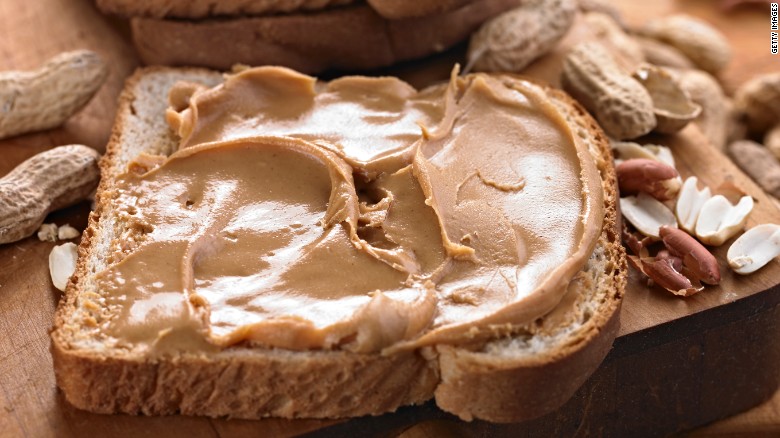Peanut-Butter Makers Face Crunch

Another hot, dry summer has devastated this year’s peanut crop, sending prices…skyrocketing and forcing peanut-butter brands including Jif, Skippy and Peter Pan into startling price increases.
Wholesale prices for big-selling Jif are going up 30% starting in November, while Peter Pan will raise prices as much as 24% in a couple weeks. Unilever wouldn’t comment on its pricing plans [for its Skippy peanut butter], but a spokesman for Wegmans Food Markets, [a]…supermarket chain in the Northeast U.S., said wholesale prices for all brands it carries, including Skippy, are 30% to 35% higher than a year ago.
Kraft Foods Inc., which launched Planters peanut butter in June, is raising prices 40% on Oct. 31, a spokeswoman said. ……….
The U.S. Department of Agriculture estimates the current spot price for a ton of unprocessed Runner peanuts, commonly used in peanut butter, at about $1,150 a ton, which is up from about $450 a year ago. A pound of shelled peanuts, meanwhile, would fetch $1.20 currently, one broker said, up from 52 cents a year ago.
The tight peanut supply means peanut-butter costs will eventually make their way to consumers, who are facing higher prices on just about everything they buy in the supermarkets. While prices for food consumed at home are broadly up 6% versus a year ago, the increase in peanut butter should be immediately noticeable and take a bite out of disposable income. A 30% increase on an 18-ounce jar of Jif would add 94 cents to the $3.14 price at a Target Corp. store in Jersey City, [NJ].
As with any crop, the challenges facing peanut farmers begin and end with the weather. In Georgia, the leading U.S. peanut producing state, the planting season was the driest in memory for John Harrell, a sixth-generation peanut farmer in Whigham, Ga. Peanuts, typically planted between mid-April and the beginning of June, had to wait until several weeks after that for any rains, he said.
“I don’t remember a year that you didn’t catch a shower or had so little moisture in the ground to get the seed up,” said Mr. Harrell, age 56. “It was dry about as deep as you can dig down.”
Compounding the problems was that some farmers devoted more of their fields to crops like cotton, which was fetching a high price. The USDA Agriculture estimates a 17% drop in the peanut crop this year, to 3.46 billion pounds.
Of added concern is the quality of the crop. Scorching heat, especially in Texas, singed many peanut plants as they developed, leaving more peanuts destined to be processed into oil, rather than the edible-quality that’s shelled and turned into peanut butter. Only 38% of the U.S. peanut crop was rated good or excellent last month, down from about 60% a year ago.
Smucker, the world’s largest peanut buyer [and maker of Jif peanut butter], is taking action to make sure it has enough peanut butter to stock shelves. It temporarily stopped making eight varieties in certain sizes, like 40-ounce jars or reduced-fat creamy spread, which won’t be available again until January.
Article Source:https://www.studentnewsdaily.com/daily-news-article/peanut-butter-makers-face-crunch/
ImageSource:"If you are vegetarian, peanut butter can be a convenient way to add protein and heart-healthy fats to your diet. Just steer clear of flavored peanut butters with sugar and cocoa butter, which can quickly turn your passion for peanut butter into consumption of calorie-rich chocolate." class="media__image media__imagecut-format media__imageresponsive owl-lazy" src="//cdn.cnn.com/cnnnext/dam/assets/170103164342-09-healthy-food-or-not-restricted-exlarge-169.jpg" style="width:75%"
VOCABULARY WORDS
1.Devastate/verb: destroy or ruin (something).
2.Crop/noun: a cultivated plant that is grown as food, especially a grain, fruit, or vegetable.
3.Disposable/adjective: (of an article) intended to be used once, or until no longer useful, and then thrown away.
4.Agriculture/noun: the science or practice of farming, including cultivation of the soil for the growing of crops and the rearing of animals to provide food, wool, and other products.
5.Estimate /verb: roughly calculate or judge the value, number, quantity, or extent of.
6.Eventually/adverb: in the end, especially after a long delay, dispute, or series of problems.
7.Typically/adverb: in most cases; usually.
8.Scorching/adjective: very hot.
9.Skyrocket/verb: (of a price, rate, or amount) increase very steeply or rapidly.
10.Meanwhile/adverb: in the intervening period of time.
11.Temporarily/adverb: for a limited period of time; not permanently.
QUESTIONS FOR DISCUSSION
1. List the following statistics provided in the article:
- wholesale price increase for Jif peanut butter
- wholesale price increase for Peter Pan peanut butter
- wholesale price increase for Kraft’s Planters peanut butter
- wholesale price increase for all peanut butter sold by Wegmans Supermarkets
- increase in price for a ton of peanuts used to make peanut butter
- increase in overall food prices over the past year
2. Which state is the leading producer of peanuts in the U.S.?
3. List the 3 factors that have contributed to the reduction in the peanut supply this year.
4. Would a 30% increase in foods made from peanuts cause your family to reduce the amount of peanut butter, etc. you buy? Explain your answer.
CHALLENGE QUESTIONS:
a) How much peanut butter do you consume in your home each month?
b) By how much will the price of your peanut butter increase per jar?
c) How much more will your family pay for peanut butter over the next year?